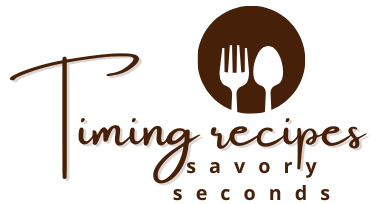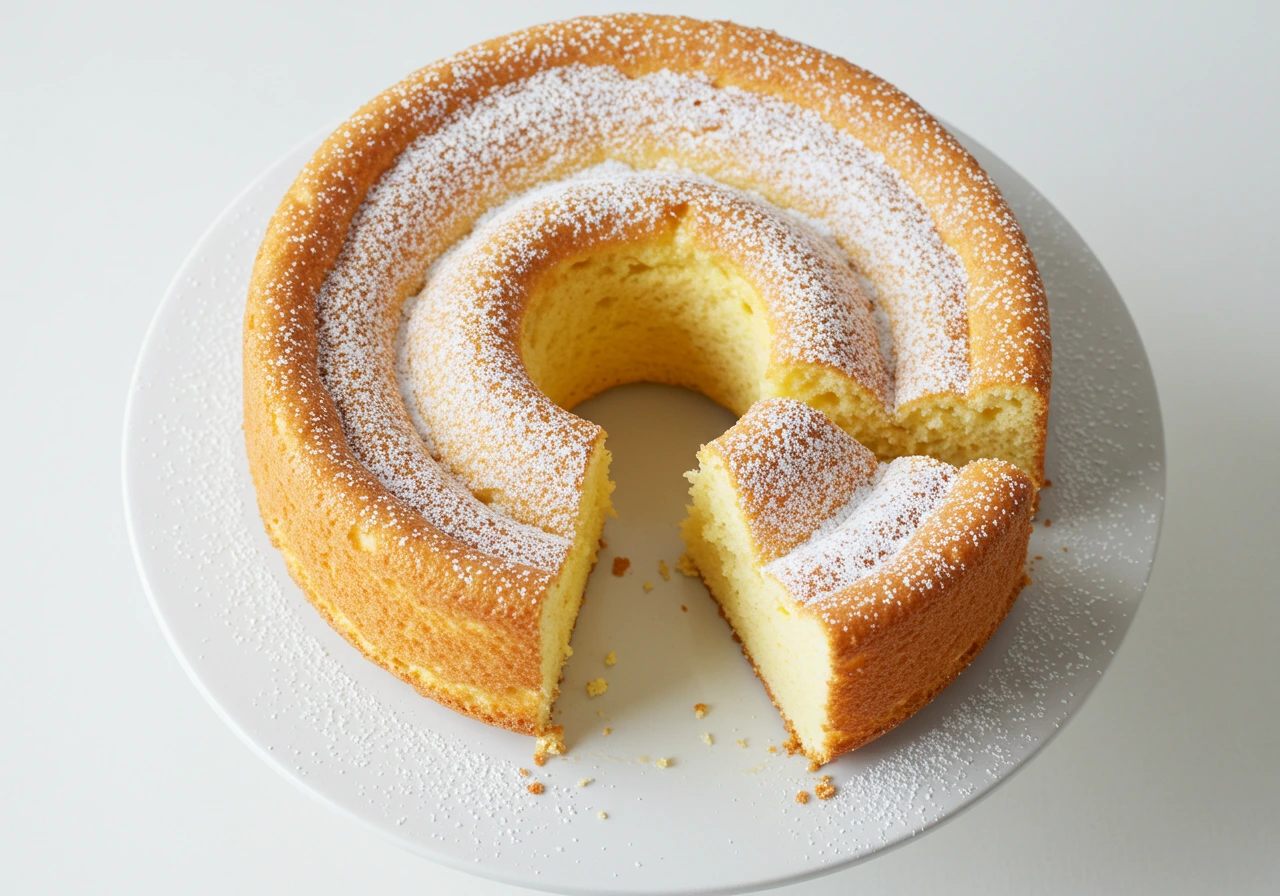Introduction to the Article
If you’ve ever dreamt of biting into a cloud, the cloud cake recipe brings you pretty darn close. This dessert is known for its airy texture, light-as-a-feather crumb, and melt-in-your-mouth softness. It’s not just a cake—it’s a fluffy slice of heaven that floats right off your plate. Whether you’re a seasoned baker or someone who’s burned toast twice this week, this guide is for you.
cloud cake recipe We’ll break down everything you need to know: from picking the right ingredients to mastering the art of whipping egg whites just right. Oh, and I’ve tried this cake myself—let’s just say, my fork kept going back for more. So, buckle in as we begin our cloud cake recipe journey with a closer look at its origins and irresistible charm.
Part 1: Introduction to Cloud Cake Recipe
What is a Cloud Cake?
At first glance, a cloud cake looks like a simple sponge. But hold up—it’s anything but ordinary. Made primarily from whipped egg whites and cream cheese, this dessert is a marriage between a soufflé and a cheesecake, often referred to as a Japanese cotton cheesecake. The result? A moist, jiggly, delicate creation that’s soft like marshmallows and just lightly sweet.
Its secret lies in the meringue—beaten until stiff peaks form, and then gently folded into a luscious batter. Once baked in a water bath, the steam creates a featherlight texture. No wonder it’s taken the internet by storm.
History and Origin of Cloud Cakes
Surprisingly, the cloud cake recipe has roots in both Western and Eastern culinary traditions. While many associate it with Japan, its concept is inspired by the classic French soufflé and New York-style cheesecakes. In the ’80s, Japanese chefs began experimenting with Western desserts, resulting in a uniquely soft cake that the world now knows as “cloud cake” or “Japanese cotton cheesecake.”
Over time, this dessert evolved into a symbol of lightness and perfection. Food bloggers embraced it. TikTokers made it viral. And now, even your neighbor down the street is giving it a go.
Popular Variations of Cloud Cakes
While the original is a minimalist beauty, cloud cake variations are becoming wildly popular. Some bakers infuse matcha for an earthy twist. Others add lemon zest or vanilla bean to heighten the aroma. You’ll also find versions topped with fresh berries or filled with citrus curd.
Even better? There are chocolate cloud cakes, coconut-infused ones, and keto-friendly alternatives using almond flour and stevia. One of my favorites? A lemon cloud cake that adds a zesty punch without losing that signature softness.
Let’s not forget vegan versions that use aquafaba (chickpea water) in place of egg whites—yes, it’s totally possible and surprisingly delightful.
In essence, this dessert is as versatile as it is delicious, and the perfect canvas for your culinary creativity. So, whether you like it plain or fancy, there’s a cloud cake out there with your name on it.
Part 2: Ingredients and Equipment for Cloud Cake Recipe
Making a cloud cake that truly floats on your fork starts with selecting the right ingredients and tools. Trust me, the first time I tried this recipe, I thought I could wing it with regular pans and casual whisking. Spoiler: it didn’t go well. But once I dialed in the essentials, my cloud cake turned out like a soft dream.
Let’s break it down so you get it right the first time.
Essential Ingredients for Cloud Cake
To craft the perfect cloud cake recipe, you don’t need a massive pantry—just a few quality staples and a little bit of patience.
Here’s what you’ll need:
- Eggs (usually 5 or 6 large ones) – the soul of the cake, especially the whites
- Cream cheese (softened) – provides body and richness
- Whole milk – balances the density
- Unsalted butter – for moisture and a silky crumb
- Cake flour – keeps the texture light and delicate
- Granulated sugar – just enough to sweeten without overpowering
- Lemon juice or cream of tartar – helps stabilize the meringue
- Vanilla extract – optional but adds a cozy, aromatic depth
Each ingredient plays a very specific role in the recipe, and using anything other than what’s listed here might make your cake sink—literally.
Role of Each Ingredient
Now, let’s dig into why each component is so important. Because this isn’t just mixing and baking—this is science meeting art.
- Egg Whites: They’re whipped into stiff peaks, trapping air bubbles that give the cake its airy, cloud-like lift. Over- or under-whipping? Say goodbye to that signature jiggle.
- Cream Cheese: Softened cream cheese blends smoothly and gives the batter its luxurious richness without weighing it down. Think velvet in cake form.
- Whole Milk & Butter: Together, these soften the cream cheese and contribute creaminess and flavor. But don’t skip the whole milk—low-fat doesn’t cut it.
- Cake Flour: Unlike all-purpose flour, cake flour is lighter and finer, which helps maintain that gentle, melt-in-the-mouth texture.
- Sugar: Divided into two parts—one for the yolk batter and one for the meringue—it sweetens and also stabilizes the egg whites when whipped.
- Lemon Juice or Cream of Tartar: These add a touch of acidity to stabilize the whipped whites and prevent them from collapsing.
- Vanilla Extract: Just a splash infuses the cake with warmth and nostalgia, though it’s totally optional.
Each measurement matters. Substitutions can ruin the delicate chemistry. So, when it comes to cloud cake, precision is your best friend.
Necessary Kitchen Equipment
Yes, it’s a short ingredient list, but the magic won’t happen without the right tools. Believe me—I tried making one without a springform pan and had to scrape the cake off the bottom in sad little pieces.
Here’s what you must have:
- Electric hand mixer or stand mixer – to whip egg whites properly (by hand? not unless you’re training for the Olympics)
- Mixing bowls (preferably glass or metal) – especially for meringue; avoid plastic, which can hold grease
- 8-inch springform pan – essential for easy unmolding
- Parchment paper – to line the base and sides (helps with smooth release and even baking)
- Baking tray for water bath – the steam is key to that soufflé-like rise
- Kitchen scale – optional but highly recommended for accuracy
Having these on hand will not only make the process smoother but help ensure success. After all, cloud cake isn’t the time for “eyeballing it.”
Part 3: Step-by-Step Cloud Cake Recipe
When it comes to baking a cloud cake, it’s all about precision, technique, and patience. From the first crack of an egg to that glorious wobble fresh out of the oven, each step builds the signature lightness that gives this dessert its dreamy name. So, let’s walk through the process, step by step. I’ve baked this more than once—made some mistakes, learned a lot—and now I’m handing you the good stuff, minus the mess.
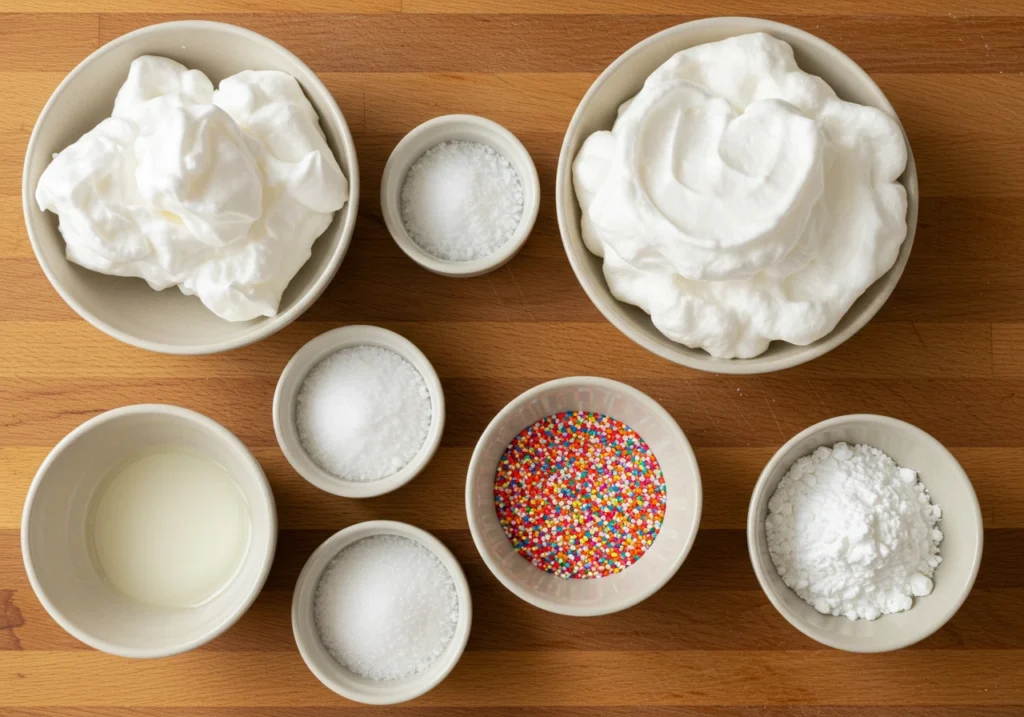
Preparing the Batter
Start strong by softening your cream cheese, butter, and milk over a gentle heat. This mixture needs to be smooth—like silk—before it even meets the eggs. I usually set up a double boiler for control. Place your cream cheese, milk, and butter in a heatproof bowl over simmering water and stir until the blend becomes smooth and glossy.
Once that’s done, remove from heat and cool slightly before whisking in the egg yolks, one at a time. Add your vanilla extract and sifted cake flour, mixing until just combined. No overmixing here—we want this batter light and barely stirred.
This yolk-based mixture is the creamy foundation of your cake. It’ll carry the rich flavor and blend beautifully with the airy meringue later. The texture should be pourable, smooth, and lump-free. If it’s clumpy, it’ll never blend well with the meringue—and you’ll lose that coveted cloud effect.
Separating and Beating Egg Whites
Here’s where the real magic happens. That dreamy, cloudlike texture hinges on perfectly whipped egg whites. But wait—let me share a secret I learned the hard way: even the tiniest drop of yolk can wreck your meringue.
Crack your eggs carefully. I recommend doing it over a separate bowl first, just in case you get some yolk in there. Use a glass or metal bowl—plastic can hold onto grease, which kills volume.
Begin beating the whites on low until they turn frothy. Then crank it up and add your sugar gradually (not all at once!) along with a splash of lemon juice or a pinch of cream of tartar to help stabilize the peaks.
Whip until you reach glossy, stiff peaks—where the meringue holds its shape but doesn’t look dry or grainy. Think shaving cream texture. Under-whipped and it’ll collapse in the oven. Over-whipped and it won’t blend properly. You’ve got a sweet spot—hit it!
Combining Ingredients
Gently is the name of the game. You’re not just dumping the meringue into the yolk mixture—oh no. You’ll fold it in like you’re tucking in a sleeping baby.
Start by adding one-third of the whipped egg whites into the yolk batter. Use a spatula to fold—never stir—and turn the bowl as you go. Once incorporated, add the remaining whites in two batches.
Here’s where your patience pays off. Rushing will deflate the air you worked so hard to whip in. The final batter should look uniform, smooth, and still hold some body—not runny or foamy.
And yes, it’s okay to have a few faint white streaks left. Better that than overmixing.
Baking the Cloud Cake
Preheat your oven to around 320°F (160°C), but here’s the twist—you’ll need a water bath for this part. Why? Because cloud cakes love a humid environment. Dry heat cracks the top, ruins the jiggle, and makes the texture denser.
Pour your batter into a prepared springform pan lined with parchment paper (sides too!). Tap gently on the counter to release air bubbles.
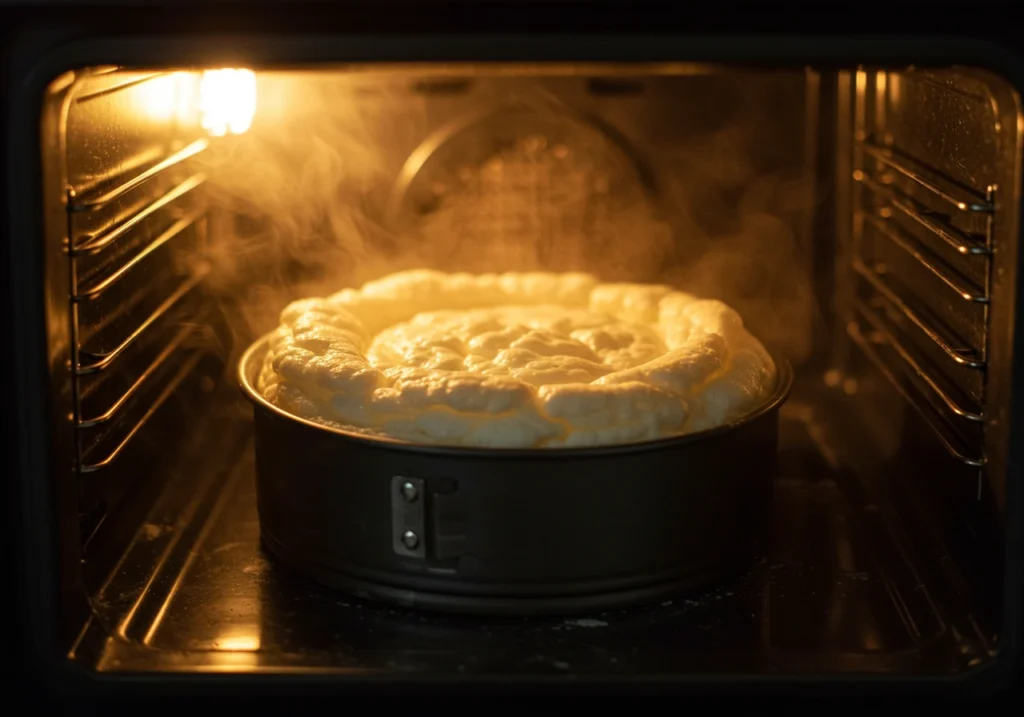
Now, place your pan into a larger baking dish filled with about 1 inch of hot water. This steamy sauna will help your cake rise gently and evenly.
Bake for the first 30 minutes at 320°F, then lower the temp to 285°F (140°C) and bake for another 30–35 minutes until a toothpick comes out mostly clean. The top should be pale golden and just barely set.
Setting Up a Water Bath
Let’s talk details: water baths (or bain-marie) seem fancy, but they’re totally doable—and totally necessary. Here’s how I do it every time.
Place your springform pan onto a sheet of aluminum foil and wrap the bottom tightly to avoid water leakage. Use two layers if needed. Next, boil some water and pour it carefully into a larger roasting tray or deep baking pan.
Set your wrapped springform pan inside the tray and make sure the water reaches halfway up the sides. This gentle, steamy environment prevents cracks, keeps the edges soft, and promotes slow, even baking. No shortcuts here—it makes all the difference.
Baking Time and Temperature
Getting the temperature right is crucial. Cloud cake recipes are a bit finicky, so a thermometer is your friend if your oven runs hot or cold.
Start with a preheated 320°F (160°C) oven, then drop to 285°F (140°C) after the first half hour. This technique creates a gradual bake and ensures the center cooks through without overbaking the exterior.
Some ovens have hotspots, so try rotating your pan gently (if safe) halfway through the bake. But don’t open the door too often—the steam needs to stay in.
Baking times can vary by oven, but plan for about 60–70 minutes total. When done, the top will look set, light golden, and slightly puffy with a satisfying wobble when gently nudged.
Cooling and Unmolding the Cake
Fresh out of the oven, your cake might look puffy and tall—but don’t panic when it deflates slightly during cooling. That’s normal. Like a soufflé, it settles into its soft, velvety form.
Turn off the oven and leave the door cracked open with the cake still inside for about 15–20 minutes. This gentle cooldown prevents sudden collapse.
After that, remove the cake and let it cool completely in the pan on a wire rack. Once it’s fully cooled, run a knife gently along the edges before unlocking the springform.
Peel back the parchment, place it on a serving plate, and voilà—your homemade cloud cake is ready to devour. Light, elegant, and absolutely magical.
Part 4: Serving and Presentation of Your Cloud Cake Recipe
You’ve baked it, cooled it, and maybe even admired that golden dome with a proud baker’s smile—but hold up, we’re not done yet. Cloud cake may be gorgeous in its pure, naked form, but dressing it up makes it go from “yum” to “YASSS!” And let’s be honest, this part is almost as fun as eating it.
In this section, you’ll learn how to style your cloud cake like a pro, whether you’re going for elegant minimalism or full-on fruit explosion. Let’s dive into the delicious details.
Decorating Ideas for Cloud Cake
Because the cake itself is light and simple, your decorations should enhance—not overpower—it. Less is often more when working with a fluffy cake recipe like this one. You want those textures to sing.
Here are a few go-to decoration styles that make your cloud cake pop:
- Whipped Cream Swirls: Pipe soft peaks of unsweetened whipped cream around the top edge for a classic bakery look.
- Fresh Fruit Toppings: Think sliced strawberries, blueberries, kiwi, or even edible flowers for that garden-fresh vibe.
- Citrus Zest: Sprinkle lemon or orange zest on top to add fragrance and a pop of color.
- Chocolate Drizzle: A touch of dark chocolate ganache drizzled artistically (not drenched!) makes it gourmet without losing the lightness.
- Toasted Coconut Flakes: Add some tropical flair—just a light sprinkle does the trick.
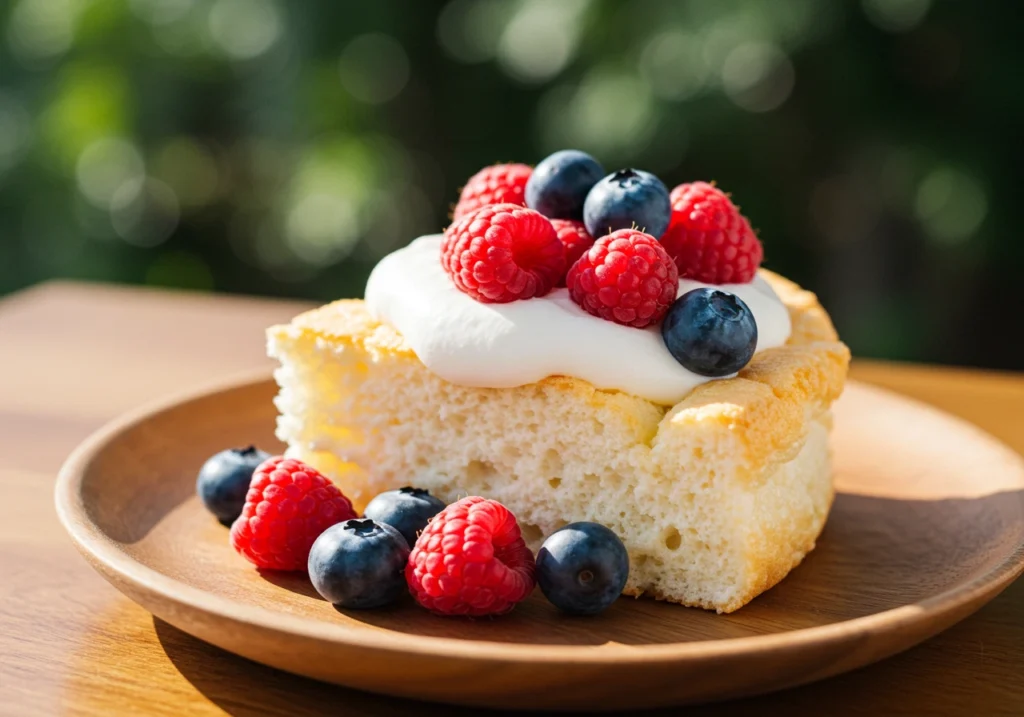
Trust me, I’ve tried both minimalist and extra-fancy versions—and each time, the presentation got almost as many compliments as the taste.
Using Whipped Cream and Fruits
Oh yes, we’re talking ultimate pairings here. Cloud cake and whipped cream? Like best friends at brunch. Add in some fruit, and suddenly, it’s a full-on party.
Use freshly whipped cream (avoid canned!) and keep it unsweetened or lightly sweetened—remember, the cake is already subtly sweet. Spoon it over the top or serve on the side for guests to build their dream bite.
When it comes to fruit:
- Berries are your safest (and prettiest) bet: strawberries, raspberries, and blueberries bring both tartness and color.
- Stone fruits like peaches or plums? Slice thinly and fan them across the cake for drama.
- Figs or passionfruit? Fancy, fragrant, and a little unexpected.
Layering whipped cream and fruit adds moisture and brightness to each bite, especially if you’re serving the cake chilled. Food52 even suggests macerating berries in a touch of citrus juice before topping—trust me, it’s a game-changer.
Dusting with Powdered Sugar
If you’re a minimalist at heart, this one’s for you. A soft cloud of powdered sugar gives your cake a snowy finish without overwhelming its flavor. It’s the quickest way to dress it up with zero prep.
Just wait until your cake is fully cooled. Then, using a fine sieve or mesh strainer, gently tap a layer of powdered sugar over the surface. That’s it. Simple, elegant, and timeless.
You can even use stencils to create pretty patterns—hearts, stars, or even custom messages.
Pro tip? Dust right before serving so it doesn’t get absorbed into the cake. The crisp white top against the golden crust is visual poetry.
Serving Suggestions
When it comes time to slice and serve, make it feel like a celebration. Because, honestly, it kinda is.
Here’s how to wow your guests (or just yourself—no shame in solo cake joy):
- Chill the cake for 30–60 minutes before serving if you prefer a firmer texture.
- Use a warm knife to slice cleanly through the delicate crumb (just dip it in hot water and wipe between slices).
- Plate with a dollop of whipped cream, a sprinkle of lemon zest, or a few fresh berries.
- Serve on elegant dessert plates or rustic ceramic for a cozy, homemade feel.
Cloud cake is naturally light, so guests often want seconds. Plan accordingly if you’re serving more than four people!
Pairing with Beverages
Pairing drinks with your light sponge cake can elevate the entire dessert experience. No need for fancy stuff here—just complementary flavors.
Some great sips to serve alongside cloud cake:
- Hot teas like jasmine, chamomile, or Earl Grey offer floral and citrus notes that enhance the cake’s subtle sweetness.
- Iced green tea brings a refreshing, slightly bitter contrast.
- Sparkling water with lemon cleanses the palate between bites.
- Freshly brewed coffee or espresso adds a rich contrast—especially delightful with a dusting of cocoa on your cake.
- Non-dairy milk (like oat or almond) works well too, especially with vegan versions.
Keep the drinks light and let the cake be the star. You’ve earned it.
Part 5: Tips, Variations, and FAQs About the Cloud Cake Recipe
Once you’ve nailed the basic cloud cake recipe, it opens the door to endless creativity—and a few lessons along the way. This section covers hard-won tips, flavor twists, frequently asked questions, and even a slice of my own personal experience baking this pillowy wonder.
Let’s fluff it up.
Tips for a Perfect Cloud Cake
To create a flawless cloud cake, every detail matters. These tips will help you sidestep flops and bring that cloud-like texture to life:
- Room-temperature ingredients: Always. Cold eggs and cream cheese won’t mix properly and could make your batter lumpy.
- Use a kitchen scale: Precision is key. A little too much flour or sugar, and you’ll lose the lightness.
- Prep your pan properly: Line both bottom and sides with parchment. This prevents sticking and keeps the cake’s edges smooth.
- Whip egg whites to perfection: You’re aiming for glossy stiff peaks, not dry ones. Under-whipping leads to collapse; over-whipping makes folding impossible.
- Fold gently: The meringue is delicate. Use a spatula, and don’t rush—preserve that airy volume.
- Water bath every time: It keeps the baking gentle and steamy, preventing cracks and rubbery texture.
- Cool it gradually: Drastic changes in temperature can cause sinking. Leave it in the oven with the door cracked for 15–20 minutes after baking.
These small steps make a big difference. One tweak and you’re on your way to cloud-like bliss.
Common Mistakes to Avoid
Even experienced bakers slip up. I sure did—my first attempt ended in a soggy base and collapsed center. Learn from these common missteps:
- Skipping the parchment paper: Big mistake. Your cake will cling to the pan like a clingy ex.
- Beating meringue too fast: High speed too soon can create large unstable bubbles—bad news for cloud cake.
- Mixing too aggressively: Folding like you’re wrestling the batter? That’ll knock out all the air.
- Opening the oven early: That steam inside? You need it. Opening the door too soon releases it and leads to sinking.
- Oven too hot: High temps cook the exterior too fast, leading to cracking and underbaked centers.
- Not using a water bath: I skipped it once—and the difference was night and day. Dry, cracked, uneven cake? Never again.
Stick to the science, show the meringue some love, and your cake will rise to the occasion.
Variations of Cloud Cake
Craving a remix? Cloud cake is a great base for flavor experimentation, and the possibilities are as vast as the sky.
Some delightful spins include:
- Matcha Cloud Cake: Add 1 tablespoon of sifted matcha powder to the yolk batter for an earthy, bittersweet flavor and vibrant green hue.
- Vanilla Bean Cloud Cake: Use the seeds of a vanilla pod for a rich, aromatic touch that feels straight from a Parisian patisserie.
- Berry Cloud Cake: Swirl in pureed raspberries or blueberries into the yolk batter before folding for a fruity twist.
- Coconut Cloud Cake: Replace part of the milk with coconut milk and sprinkle toasted coconut on top post-bake.
- Vegan Cloud Cake: Use aquafaba (chickpea brine) to whip a faux meringue and swap out dairy with plant-based options.
Cloud cake is like a blank (but tasty) canvas. Just don’t go too wild with wet ingredients or your structure might suffer.
Chocolate Cloud Cake
Oh yes—it exists. Chocolate cloud cake brings rich cocoa into the mix without sacrificing the signature fluff.
To make it:
- Add 2 tablespoons of high-quality unsweetened cocoa powder to the yolk batter. Sift it with the flour to avoid lumps.
- Some bakers (like Nigella!) even add melted dark chocolate to the cream cheese mixture for added richness.
- A tiny pinch of espresso powder enhances the cocoa flavor beautifully.
Once baked, the cake has a delicate chocolate profile—light but decadent. Serve with a dollop of cream and chocolate shavings for ultimate satisfaction.
Lemon Cloud Cake
Bright, zesty, and refreshing—lemon cloud cake is the perfect springtime or summer variation.
Here’s how to nail it:
- Add 1 tablespoon of fresh lemon juice and 1 tablespoon of zest to your yolk batter.
- You can also top it with a lemon glaze (just powdered sugar + lemon juice) once cooled for extra zing.
- Pair it with whipped cream and candied lemon slices for that wow factor.
This version cuts through the richness with a pop of citrus and feels lighter on the palate—ideal for warm days or fancy brunches.
Frequently Asked Questions (FAQs)
Is cloud cake the same as angel food cake?
Not quite. cloud cake recipe uses cream cheese and yolks, while angel food cake is made only with egg whites and no fat, resulting in a drier, spongier texture. Cloud cake is softer, creamier, and a bit more luscious.
What was Queen Elizabeth’s favorite cake?
While not exactly a cloud cake, Queen Elizabeth was famously fond of a chocolate biscuit cake—made from crushed tea biscuits and chocolate. That said, the texture of cloud cake might’ve fit her elegant taste.
What is the most delicious cake in the world?
That’s subjective! Some swear by sachertorte, others by red velvet. But many foodies agree that a well-made Japanese souffle cake (a.k.a. cloud cake) holds its own thanks to its light texture and balanced sweetness.
How to make cloud shape cake?
To make your cake look like a literal cloud, use a cloud-shaped silicone mold. These are popular in modern patisserie. Finish with glossy glaze or whipped cream swirls to mimic cloud fluffiness. For aesthetics only—the flavor’s already sky-high.
Personal Experience with Cloud Cake Recipe
Let me tell you, the first time I made this, it felt like performing a delicate dance. I was skeptical—”Just egg whites and cream cheese?” But the moment I pulled it out of the oven, golden and jiggly, I was hooked.

I’ve tested it on rainy days, humid mornings, and even with a questionable oven. And every single time I stuck to the process—measured with a scale, folded with love, used the water bath—it delivered. The way guests gasp when the cake wobbles? Priceless.
So, yes—I’ve made it. Loved it. And now I’m obsessed. If you’re looking to wow a crowd or simply float into dessert heaven, this cloud cake recipe is your next baking adventure.
